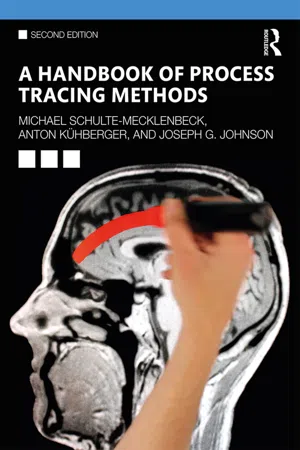Saccades
For JDM studies and cognition more generally, one type of eye movement is the most relevant: saccades (Henderson, 2006). These are rapid, voluntary movements of widely different amplitude from one object of regard to another. Historically, the broad reliance on a sequence of saccades to accomplish most cognitive tasks was not appreciated until the end of the 19th century. Instead, the eye was thought to move more continuously, especially in such common visual tasks as scanning scenes, search, and reading. Unlike most of our movements, we do not notice our own eyes move. For example, you have no awareness of your own saccades as you read this sentence, but you can clearly observe another reader’s eyes leap from one word to another and down to the next line. Such movement was labeled “par saccade” by the French physiologist Javal, and can be translated roughly as movement “by fits and starts”, with the single word “saccade”2 corresponding to something like the English words “jerk” or “leap” (Wade, 2007).
See Wade and Tatler (2005) for comprehensive histories of eye movement research and the much earlier detailed review in Chapter 2 of Yarbus (1967). The performance capabilities of saccades are well documented (e.g., Carpenter, 1988; Becker, 1991). These movements are rapid, reaching a peak velocity of 700° per sec for longer movements. When acceleration and deceleration are incorporated, a 2° saccade that is typical in reading takes about 25 msec, while a 6° movement that might occur in scanning a visual scene requires about 35 msec.
An important characteristic of saccades is the “suppression” of vision during movement (Matin, 1974; Thiele, Henning, Buischik, & Hoffman, 2002).3 During a saccade, essentially no information can be acquired, certainly not the recognition of alphanumeric characters in typical JDM tasks.4
Among voluntary movements, saccades are so effortless that they usually go unnoticed. Thus, we recognize errors in other voluntary movements like motor “missteps”, but there are no “misfixations”. We may fixate something anticipated to be interesting and then find that it is not, but the error is one of prediction, not one of incorrectly executing a saccadic movement. Even when the movement is aimed imperfectly, the control system of the eye rapidly corrects its aim and accomplishes the necessary adjustment so effortlessly that the correction is no more recognized than the original saccade. In contrast, a misstep while walking, even when it is corrected in time to avoid tripping, is often a more conscious action, likely eliciting embarrassment when done in a public situation.
Non-Saccadic Movements
There are other movements of the eyes besides saccades. In vergence movements, the eyes jointly focus on a single point or object of regard. They contribute to both visual acuity and depth perception. Smooth pursuit movements allow the eye to track an object that follows a continuous trajectory. Such movements maintain the target at a fixed point on the retina, usually the fovea, in order to attain sufficient resolution for such ordinary actions as walking over uneven terrain. Nystagmus movements enable constant focus on an object of regard when the head moves. Such compensatory movements are essential to vision as observers move through their environment. There are also very small movements (tremors, drifts, and flicks) that will, in most cases, not concern JDM researchers. For a more detailed description of the varieties of eye movements, see Kowler (1995; 2011) or Duchowski (2017, especially Chapter 4).
